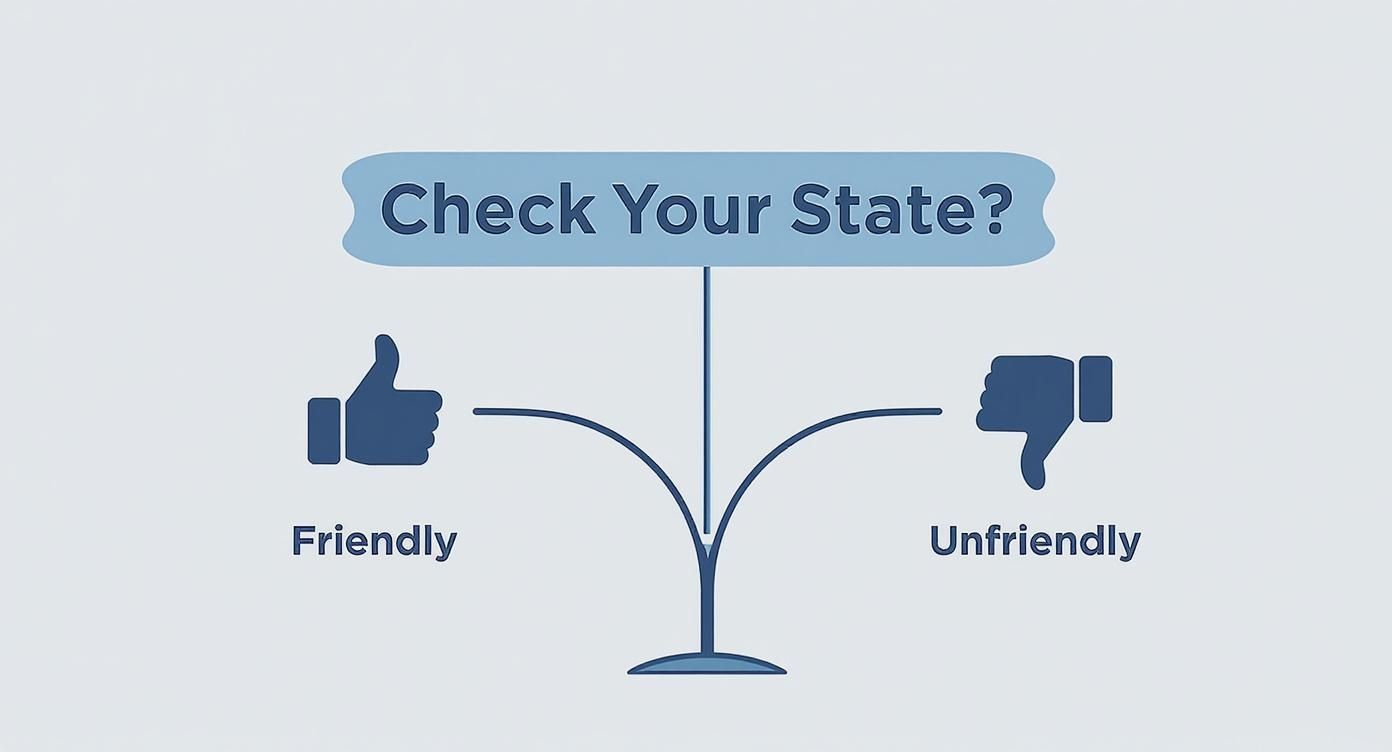After an accident, even perfect repairs can’t erase the damage history from your car’s record. This permanent mark has a real financial cost, dragging down your vehicle’s resale value. This loss is called diminished value, and if an Allstate-insured driver caused the crash, you have the right to file an Allstate diminished value claim to recover that money.
Your Right to Fair Compensation

When another driver hits your car, their insurance pays for the physical repairs. However, those repairs don’t restore your vehicle’s full pre-accident value. The accident now lives on its vehicle history report, creating a stigma that scares away potential buyers. Frequently Asked Questions about All State Diminished Value Claims.
Put yourself in a buyer’s shoes. Given two identical cars—one with a clean record and one with a prior accident—which would you choose? Most buyers will select the one with a clean history or demand a steep discount for the damaged one.
That price drop is its inherent diminished value. Filing an Allstate diminished value claim is simply the process of holding their insured accountable for this very real form of property damage.
Are You Eligible to File a Claim?
Before diving in, confirm your eligibility. It generally comes down to two scenarios:
- Third-Party Claims: This is the most common situation. An Allstate-insured driver hits your car, and you file a diminished value claim against their policy. Their insurance is responsible for making you “whole,” which includes compensating you for the lost market value.
- First-Party Claims: This is less common and involves filing a claim against your own Allstate policy. This is only possible in a few states, like Georgia, due to specific laws. Check your policy and state-specific diminished value law pages to see if you qualify.
Key Takeaway: The principle behind a diminished value claim is simple: You shouldn’t lose money because of someone else’s mistake. The drop in your car’s resale value shouldn’t be your financial burden.
However, getting Allstate to pay can be challenging. They are known for using tough negotiation tactics to minimize payouts. This is why you must build a rock-solid case from the start to get the fair settlement you deserve.
Gather the Proof You Need for Your Claim

A successful Allstate diminished value claim requires more than just asking for money; it requires presenting a demand backed by undeniable proof. Your goal is to make it easier for the adjuster to approve your claim than to fight it.
Essential Document Checklist
Start by collecting the necessary paperwork to establish the facts.
- The Police Report: This is the official record proving the Allstate-insured driver was at fault—a must-have for any third-party claim.
- Before-and-After Photos: Document the initial damage, the repair process, and the finished product from multiple angles to create a clear visual record.
- The Final Repair Invoice: This itemized list of parts and labor is concrete proof of the repair’s scope. Highlight any structural work or the use of non-OEM parts.
The Game-Changer: A Certified Diminished Value Appraisal
The documents above prove the accident happened, but they don’t prove your car value after the accident has dropped. For that, you need the single most important tool: a certified, independent diminished value appraisal.
An adjuster’s job is to minimize payouts, and they are trained to dismiss claims lacking professional, data-backed proof. Simply telling them your car is worth less is not enough.
A professional report from a service like SnapClaim changes the dynamic. It makes the argument for you, using the same valuation methods recognized by courts to provide the proof you need to negotiate fairly.
A certified appraisal delivers a specific, defensible dollar amount by analyzing comparable vehicle sales, auction data, and your car’s repair history. It replaces your opinion with cold, hard facts. You can learn more in our detailed guide on decoding diminished value appraisal costs.
How to Calculate Your Vehicle’s True Lost Value
When you file an Allstate diminished value claim, the key question becomes: how much is your claim worth? Allstate’s initial offer will likely be much lower than you expect, as this is a standard tactic.
Insurance companies often use simplistic, flawed formulas like the “17c formula” to calculate your loss. This method uses arbitrary modifiers and caps that systematically reduce your compensation, leaving you with a fraction of what you’re owed.
Understanding the Three Types of Diminished Value
To counter lowball offers, you must understand what you are claiming. Diminished value breaks down into three types:
- Immediate Diminished Value: The loss in value right after an accident but before repairs. This isn’t typically used in claims.
- Repair-Related Diminished Value: Loss from shoddy repairs, like mismatched paint or poor panel alignment. This is usually resolved by the body shop.
- Inherent Diminished Value: This is the core of your claim. It’s the automatic loss in value that exists because the vehicle now has an accident on its history report, even after flawless repairs.
Your Allstate diminished value claim seeks compensation for inherent diminished value—the permanent stigma that reduces your vehicle’s fair market value.
Why a Professional Appraisal is Superior
A certified appraisal from SnapClaim ignores flawed formulas like 17c. Instead, it uses a comprehensive, market-driven methodology to pinpoint your real-world financial loss based on verifiable data.
A professional appraiser analyzes your vehicle’s pre-accident condition, the severity of the damage, the quality of repairs, and local market data for comparable vehicles. This data-backed approach provides a credible figure that withstands an adjuster’s scrutiny. To learn what goes into a report, see our guide on how to read an appraisal report.
Professional Appraisal vs. Insurer Formula
The difference between the two methods shows why an independent report is essential.
| Valuation Factor | SnapClaim Certified Appraisal | Typical Insurer Formula (e.g., 17c) |
|---|---|---|
| Base Value Source | Real-time market data from multiple sources (dealerships, auctions, private sales). | Often starts with a generic book value (like NADA) which may not reflect local market conditions. |
| Damage Severity | Considers the full scope, including structural vs. cosmetic damage and parts replaced. | Applies a simple, arbitrary multiplier (e.g., 0.25 for minor damage, 0.75 for major). |
| Market Analysis | Analyzes sales of comparable wrecked-and-repaired vehicles to establish a real-world loss. | Ignores actual market data entirely. The calculation is purely internal and formulaic. |
| Vehicle Condition | Accounts for pre-accident condition, mileage, options, and maintenance history. | Applies a generic mileage modifier, often penalizing you unfairly for average use. |
| Final Figure | A specific, data-backed number representing the true market value loss. | An artificially low number capped at a percentage of the vehicle’s pre-accident value. |
Presenting a certified appraisal forces Allstate to abandon its flawed formulas and negotiate based on facts, not opinion. It provides the proof you need to negotiate fairly.
Submitting Your Demand Letter to Allstate

With your certified appraisal, you are no longer just asking for compensation—you are formally demanding it. Your demand letter is the opening move in the negotiation and is key to a successful Allstate diminished value claim.
This package should lay out your case in a clear, organized, and undeniable way. It signals to the adjuster that you are serious, informed, and prepared to stand your ground with evidence.
Crafting an Effective Demand Letter
Your letter must be firm, professional, and factual. Stick to the evidence and avoid emotional language.
Your demand package should include:
- Your Contact Information: Full name, address, and phone number.
- Claim Details: The Allstate claim number, date of the accident, and name of their insured.
- A Clear Statement: Open by stating you are making a formal demand for the inherent diminished value of your vehicle.
- The Demand Amount: State the exact dollar amount from your certified appraisal report.
- Supporting Documents: Attach copies of the police report, final repair invoice, photos, and your complete SnapClaim appraisal report.
Key Takeaway: Your demand letter should make your position crystal clear. You are presenting a legitimate claim for damages caused by their insured, supported by expert analysis.
Send your demand package via certified mail for a delivery receipt. Now, prepare for Allstate’s common negotiation tactics.
Preparing for Allstate’s Response
Don’t be discouraged if Allstate’s first response is a denial or a lowball offer. It’s a deliberate strategy designed to wear you down.
Expect one of these moves:
- Outright Denial: The adjuster may incorrectly claim they “don’t pay” for diminished value.
- The Lowball Offer: They might offer a small “nuisance” amount, hoping you’ll take the quick cash.
- Questioning Your Appraisal: They may try to discredit your report and insist on their internal valuation.
The legal precedent for diminished value is well-established. Landmark cases and settlements confirm that inherent diminished value is a real, compensable loss. You can find more on insurance litigation across all 50 states. Your certified appraisal is the best weapon against these tactics, allowing you to calmly refer the adjuster back to market data and professional analysis.
How State Laws Impact Your Claim
Your success with an Allstate diminished value claim depends heavily on your location. State laws are often the single biggest factor in determining how straightforward your negotiation will be.
Some states are very consumer-friendly, with court rulings that explicitly recognize diminished value as a recoverable damage. In others, the rules are less clear, giving insurers more room to push back.
Why Your State’s Legal Climate Matters
Knowing your state’s legal landscape is critical.
- Claim-Friendly States: Places like Georgia have a history of pro-consumer court decisions, making it easier to pursue and win a diminished value claim.
- Challenging States: Other states may lack specific laws or favorable rulings, requiring a more robust, evidence-heavy approach.
Find detailed information for your area on our state-specific diminished value law pages. Knowing your rights is the first step to success.
How Court Rulings Shape Insurer Behavior
Legal precedents have a powerful impact. When courts rule against an insurer in a diminished value case, it sets a standard that helps future claimants in that state.
However, rulings can also favor insurers. A recent U.S. 5th Circuit Court decision found that Allstate hadn’t broken Mississippi law by excluding diminished value in its policies. This highlights that unless state law forces coverage, insurers can legally deny first-party claims. Learn more about how court rulings impact insurer obligations on InsuranceJournal.com.
Key Insight: Your claim’s success boils down to two things: your state’s laws and the quality of your evidence. A data-backed, defensible appraisal report is non-negotiable, especially in states with less favorable laws.
This legal maze is why a generic online calculator or form letter rarely works. Your claim must be built on professional analysis that aligns with the legal standards where you live, allowing you to negotiate from a position of strength.
What to Do When Allstate Won’t Pay a Fair Amount
You’ve submitted your Allstate diminished value claim, but their response is disappointing. This is a common hurdle, but it’s not the end of the road. A lowball offer is a test of your resolve.
With a solid appraisal in hand, you are presenting evidence, not just an opinion. It’s time to shift from asking to demanding. Your next steps can depend heavily on your state’s laws.

Knowing where your state stands gives you a strategic advantage.
Rebut the Adjuster’s Assessment
Formally push back with a detailed rebuttal. Use your SnapClaim appraisal to attack the weaknesses in the adjuster’s reasoning. If they used the flawed 17c formula, call it out. If they ignored comparable sales in your report, point to the specific examples. Dismantle their argument piece by piece with facts.
File a Complaint with the Department of Insurance
If Allstate ignores your rebuttal, escalate the issue by filing a complaint with your state’s Department of Insurance (DOI). This action:
- Puts Allstate on record with a government regulator.
- Forces a formal, written response from a higher-level employee.
While the DOI can’t force payment, the threat of regulatory scrutiny often brings an adjuster back to the negotiating table.
Invoke the Appraisal Clause or Go to Small Claims Court
If the claim is for a significant amount, you have two strong options. First, check the at-fault driver’s policy for an appraisal clause. This provision lets both sides hire independent appraisers, with a neutral umpire making the final call if they disagree.
Your other option is small claims court. It’s designed for disputes like this, with low filing fees and no need for a lawyer. Your SnapClaim report is court-ready evidence that gives the judge a clear, expert-backed document to base their decision on.
When to Consider Legal Counsel
For high-value claims or if you suspect bad faith tactics, hiring an attorney can change the dynamic. A letter from a lawyer signals to the insurance company that you are serious.
If Allstate continues to resist, a professional can handle all communications and file a lawsuit if necessary. For a vehicle that has lost significant value, locating a car accident law firm is often the best way to recover the full compensation you are owed.
Frequently Asked Questions About Allstate DV Claims
Navigating an Allstate diminished value claim can be confusing. Here are answers to some common questions.
Can I file a diminished value claim if the accident was my fault?
Almost certainly not. In nearly every state, you can only file a diminished value claim against the at-fault driver’s insurance—this is known as a third-party claim. Filing against your own policy (a first-party claim) is only allowed in rare circumstances, such as in Georgia. Always check your state’s specific laws.
Does Allstate have to pay my diminished value claim?
Yes, legally, they are required to “make you whole” if their insured caused the accident, and that includes compensating you for your vehicle’s lost resale value. However, Allstate is known for making this process difficult. Your success depends on presenting undeniable proof of your loss, which is why a certified appraisal that supports your case with certified data is so critical.
How long do I have to file a diminished value claim?
Your deadline is determined by your state’s statute of limitations for property damage, which typically ranges from one to six years from the date of the accident. It’s always best to act quickly to ensure you can gather all necessary documents and build a strong case.
Is it worth hiring a lawyer for my claim?
For most claims, a certified appraisal from SnapClaim and firm negotiation are sufficient. However, consider hiring an attorney if:
Your vehicle is a high-value, luxury, or new model.
The damage was severe, especially if it involved the frame or structure.
Allstate is negotiating in bad faith or using unreasonable delay tactics.
A SnapClaim report helps strengthen your claim with the evidence needed for a fair negotiation. And with our Money-Back Guarantee, you can proceed with confidence. If your insurance recovery from the claim is less than $1,000, SnapClaim refunds the full appraisal fee—guaranteed.
Ready to get the compensation you deserve? Get your free estimate today or order a certified appraisal report to strengthen your insurance claim.
About SnapClaim
SnapClaim is a premier provider of expert diminished value and total loss appraisals. Our mission is to equip vehicle owners with clear, data-driven evidence to recover the full financial loss after an accident. Using advanced market analysis and industry expertise, we deliver accurate, defensible reports that help you negotiate confidently with insurance companies.
With a strong commitment to transparency and customer success, SnapClaim streamlines the claim process so you receive the compensation you rightfully deserve. Thousands of reports have been delivered to vehicle owners and law firms nationwide, with an average of $6,000+ in additional recovery per claim.
Why Trust This Guide
This guide was reviewed and verified by SnapClaim’s auto appraisers, who specialize in diminished value and total loss disputes. Our team continually updates every article to reflect current insurer guidelines, valuation standards, and court-accepted appraisal practices, ensuring that you’re relying on information trusted by professionals nationwide.
Get Started Today
Whether you’re challenging a low total loss settlement or proving your vehicle’s post-repair loss in value, SnapClaim makes it simple to take the next step. Generate a free diminished value or total loss estimate in minutes and see how much compensation you may be owed.
👉 Get your free diminished value estimate today




